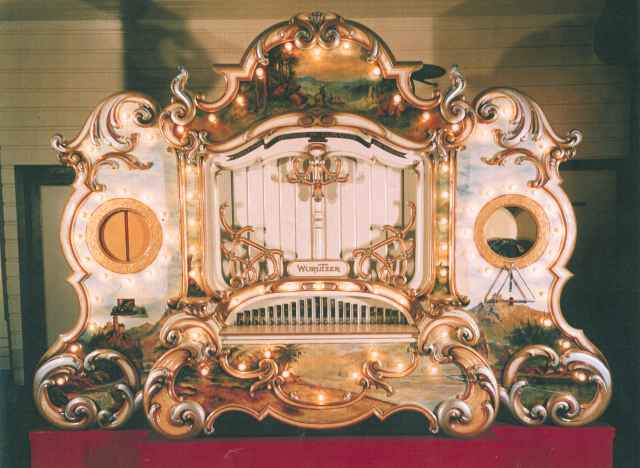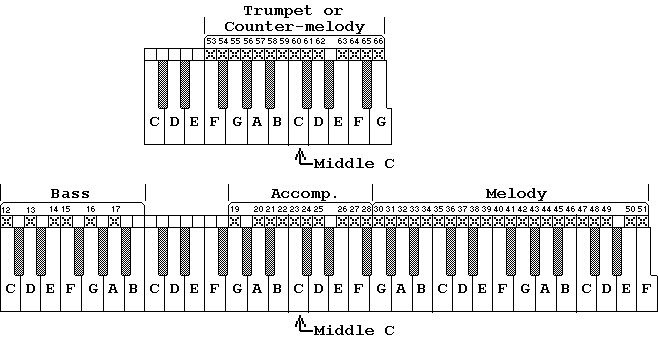| You Are Not Logged In | Login/Get New Account |
|
Please Log In. Accounts are free!
Logged In users are granted additional features including a more current version of the Archives and a simplified process for submitting articles. |
|
MMD
 Gallery
Gallery
 Tech
Tech
 W165spec
W165spec
|
|
compiled by Robbie Rhodes
file: W165spec
revised: 960417 - info from David Wasson, Eric Miller 2-7-87 data
revised: 990217, 001222 - Matthew Caulfield
COMPILER: Robbie Rhodes, April 1996
DATA SOURCE: Wurlitzer catalog, Don Rand, Matthew Caulfield
BUILDER: Rudolph Wurlitzer Co.
STYLE: No. 165 Duplex Orchestral Organ
POWER: Electric motor
MUSIC: Wurlitzer Style 165 music roll
DESCRIPTION (from Wurlitzer catalog)
Case: oak veneered, finished natural, with highly decorated white enamel
fancy front; wings detachable. Can be furnished with or without statues.
Equipped with Duplex Tracker Frame.
Dimensions with front on:
Height 8 feet 5 inches
Width 12 feet 8 inches
Depth 4 feet 4 inches.
Dimensions without front:
Height 5 feet 10-1/2 inches
Width 6 feet 5 inches
Depth 3 feet
Weight, packed for shipment: 3,000 pounds
TOTAL PIPES: 256
DESCRIPTION (by Matthew Caulfield)
There are 8 ranks in the melody section, controlled by 4 register controls
(#9,10,68,69). Going from front to rear, ranks 1 and 2 are violins (who
knows whether "loud" or "soft"?). (I've never seen a 165 with any
difference between the "loud" and the "soft" violins, though Doyle Lane's
pipe scale book shows in one place that they should be different, in
another that they are identical). Both ranks are planted in a common
sub-chest, with its single register control. Ranks 3 and 4 are also
violins, arranged the same way are ranks 1 and 2.
Ranks 5 and 6 are a rank of flageolets and a rank of open piccolos, planted
as are the other twinned ranks on a common subchest, with its single
register control. Ranks 7 and 8 are a rank of stopped flutes (or piccolos)
and a rank of open flutes, likewise on a common subchest with single
register control. Because the pipes in the stopped rank are only half the
height of the pipes in the open ranks, they are on longer feet to raise
their tops to a height uniform with the other 7 melody ranks.
The pipes in the melody ranks are planted so that the lowest notes are in
the center of the rank and the highest are at each end of the rank.
However the 3 endmost pipes on each side of the open flute rank (rank 8)
have holes drilled in the back of the pipe midway up the pipe (for reasons
I forget, but a better organ man than I am can probably tell you), so that
they are taller than they would normally be.
PLAYER SYSTEM:
medium: punched paper roll
transport: paper is pulled by take-up spool,
at constant revolutions per minute
initial paper speed: typical 8.3 feet per minute, adjustable
reader: pneumatic, suction, rectangular hole, hole height = ?
diameter of punched hole: 0.073 inch (1.85 mm), round
width of paper: 9.6250 inches
take-up spool diameter: 3.0 inches
supply spool core: 2.00 inches inside diam., 2.25 inches outside diam.
channel spacing:
per Mike Kitner: 0.1227 inch per key (20 inches per 163 keys)
distance, bass edge to center of channel #1:
per David Wasson: 0.218 inch
per Mike Kitner: symmetrical about centerline.
total quantity of possible channels: 75
total quantity of active channels: 69 (W165), 75 (W166)
divisions and quantity of channels in division (W165):
W165 W166 Division
6 6 keys bass
10 10 keys accompaniment
22 22 keys melody
14 14 keys trumpet (counter-melody)
7 5 keys percussion
2 2 keys swell shades
14 10 keys controls
75 69 keys total
INSTRUMENTATION & CONTROLS --- (revised 960417 per Eric Miller data)
BASS div, 6 keys (span: 36C1 - 45A1)
18 pipes--
6 8' stopped (always playing)
6 8' open (always playing)
6 8' Wood Trombone (#70)
ACCOMPANIMENT (ACC) div, 10 keys (span: 55G2 - 66F#3)
20 pipes --
10 8' stopped (always playing)
10 8' open (#1)
TRUMPET (TRPT) div, 14 keys (span: 53F2 - 67G3)
42 pipes --
14 wood bassoon (always playing)
14 wood viola (always playing)
14 wood trumpet (#8)
MELODY (MEL) div, 22 keys (span: 67G3 - 89F5)
176 pipes, 22 bells --
22 wood violin (#69)
22 wood violin (#69)
22 wood violin (#9)
22 wood violin (#9)
22 wood flagolet (#10)
22 wood piccolo (#10)
22 stopped flute (#68)
22 fl. octave (picc) (#68)
22 glockenspiel (#6)
PERCUSSION (PER), 5 keys
bass drum & cymbal (#67)
crash cymbal (#7)
triangle (#4)
snare drum, reiterating (#11)
castanets (#72)
SWELL SHADES (SWL), 2 keys
swell shutters closed (#5)
swell shutters open (#71)
CONTROLS (CTL), 11 keys
Rewind (#29) (appears only at the end of roll)
Coin trip (#18) (optional motor shut-off, after each song)
Cancel/Declenche (#52)
wood trombone (#70) BASS
wood trumpet (#8) TRPT
glockenspiel (#6) MEL
flute & piccolo (#68) MEL
flageolet & octave piccolo (#10) MEL
violin 'A' (#9) MEL
violin 'B' (#69) MEL
glockenspiel (#6) MEL
RESERVED (RES) KEYS, 6 keys (used by Wurlitzer 166)
Melody division:
Prestant and violin (#75)
Percussion division:
tympani (#74) [tympani added later on many 165's]
Expression division:
snare drum FF (loud) (#73) [roll coding indicates also for bass drum]
Controls:
Una-Fon bells (#3) BASS (Deagan Una-Fon)
bass bells (#1) BASS
brass trombone (BASS) & brass trumpet (TRPT) (#2)
-------------
Totals:
6 bass
10 accomp
14 trumpet
22 melody
5 percussion
2 swell shades
11 controls
___
70 total active keys for W165 instrument
5 reserved keys (added in W166 instrument)
___
75 total keys, W165 music roll format
Channel assignments (from Don Rand, circa 1980)
chan type div name
1 CTL ACC bass bells on (W166 only)
2 CTL TRPT Trumpet & BASS Brass Trombone on (W166 only)
3 CTL MEL Una-Fon bells on (W166 only)
4 - PER Triangle
5 SWL - Swells Off
6 CTL MEL Bells on
7 - PER Crash Cymbal
8 CTL TPT Wood Trumpet on
9 CTL MEL Violin 1 on
10 CTL MEL Piccolo & Flagolet on
11 - PER Snare Drum (reit.)
12 - BASS begin 6 bass div 12..17
18 CTL - COIN TRIP
19 - ACC begin 10 accomp div 19..28
29 CTL - REWIND
30 - MEL begin 22 mel 30..51
52 CTL - CANCEL (Declenche)
53 - TRPT begin 14 TRPT div 53..66
67 - PER bass Drum
68 CTL MEL Flute
69 CTL MEL Violin 2 (celeste)
70 CTL BAS Wood Trombone
71 SWL - Swells Open
72 - PER Castanets
73 - PER Snares FF (W166 only)
74 - PER Kettle drum (W166 only)
75 CTL MEL Prestant & Violin on (W166 only)
CHANNEL ASSIGNMENTS - channel (key) number, assignment
channel: 12 13 14 15 16 17
BASS: C D E F G A
channel: 19 20 21 22 23 24 25 26 27 28
ACCOMP G A A# B C C# D E F F#
channel: 30 31 32 33 34 35 36 37 38 39 40 41 42 43
MELODY G G# A A# B C C# D D# E F F# G G#
channel: 44 45 46 47 48 49 50 51
MELODY A A# B C C# D E F
channel: 53 54 55 56 57 58 59 60 61 62 63 64 65 66
TRUMPET F F# G G# A A# B C C# D E F F# G
channel: PERCUSSION & CONTROLS:
1 ACC bass bells
2 CTR Trumpets & BAS Trombone
3 MEL Una-Fon bells
4 PER Triangle
5 - Swells Close
6 MEL Bells on
7 PER Crash Cymbal
8 CTR Wood Trumpet on
9 MEL Violin 1
10 MEL Piccolo & Flagolet
11 PER Snare Drum (reit.)
18 - NICKEL TRIP
29 - REWIND
52 CANCEL
67 PER bass Drum
68 MEL Flute
69 MEL Violin 2 (celeste)
70 BAS Wood Trombone
71 - Swells Open
72 PER Castanets
73 - Snares FF
74 PER Kettle drum
75 MEL Prestant & Violin
-------------------------
PITCH TRANSPOSED: no.
DESCRIPTION OF RANKS, percussion and controls/stops:
division name, quantity of keys & total quantity of pipes in division
quantity of pipes in the rank, range of rank
rank name, range [..], true sound pitch of longest pipe in the rank
air column length of longest pipe
BASS 6 keys [C,D,E,F,G,A]
18 pipes--
6 8-foot stopped flute 8' [C..A] C =
6 8-foot open flute 8'
6 8-foot reed Wood Trombone
ACCOMP 10 keys [G..F#}
20 pipes --
10 stopped flute 2'
10 open flute 2'
MELODY 22 keys [G..G}
176 pipes --
44 violin 'A' (double)
44 violin 'B' (double)
22 flagolet
22 open piccolo
22 stopped flute
22 open fl. (piccolo)
22 bells
TRUMPET (counter-melody) 14 keys [F..G]
14 wood bassoon
14 wood viola
14 wood trumpet
PERCUSSION 6 keys
snare drum, reiterating
bass drum + cymbal
crash cymbal
triangle
castanets
CONTROLS & STOPS 13 keys
Control precedence:
Stop "on" always takes precedence over Declenche (cancel/release).
TIME DELAYS
Bass drum: delay = 85 millisecond (msec) from key "on",
duration 106 msec typ.
Snare drum: delay = 37 msec from key "on",
charging duration 50 msec typical.
This is how I would connect the pouch switches and tracker bar to play a Wurlitzer Style 165 music roll on a pipe organ, by connecting the pouch switches directly to the key contacts of the keyboards of the organ console. 1. The W165 Accompaniment channels (tracker bar 19-28) would be wired to the Great keyboard such that channel 23 plays Middle C of the keyboard and so fundamental pitch C=262 Hz would sound when an 8-foot voice is selected. 2. The W165 Bass channels (tracker bar 12-17) would be wired to the Pedal keyboard such that channel 12 plays two octaves below Middle C of the keyboard and so a note of fundamental pitch C=65.5 Hz would sound when an 8-foot voice is selected. 3. The W165 Melody channels (tracker bar 30-51) would be wired to the Swell keyboard such that channel 35 plays one octave above Middle C of the keyboard and so fundamental pitch C=524 Hz would sound when an 8-foot voice is selected. 4. The W165 Trumpet channels (tracker bar 53-66) would be wired to the Solo keyboard such that channel 60 plays Middle C of the keyboard and so fundamental pitch C=262 Hz would sound when an 8-foot voice is selected. After wiring the pouch switches to the keys of the pipe organ console, then begins the fun of listening to the music and finding stop settings (and maybe registration "presets") so that the music sounds nice! 20 February 1999, rev. 19 January 2004 |
|
|
|
|
|
|
|
|
|
CONTACT FORM: Click HERE to write to the editor, or to post a message about Mechanical Musical Instruments to the MMD Unless otherwise noted, all opinions are those of the individual authors and may not represent those of the editors. Compilation copyright 1995-2026 by Jody Kravitz. Please read our Republication Policy before copying information from or creating links to this web site. Click HERE to contact the webmaster regarding problems with the website. |
|
|
||||||
|

